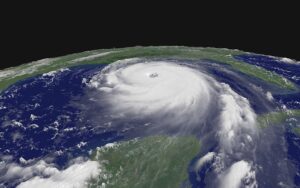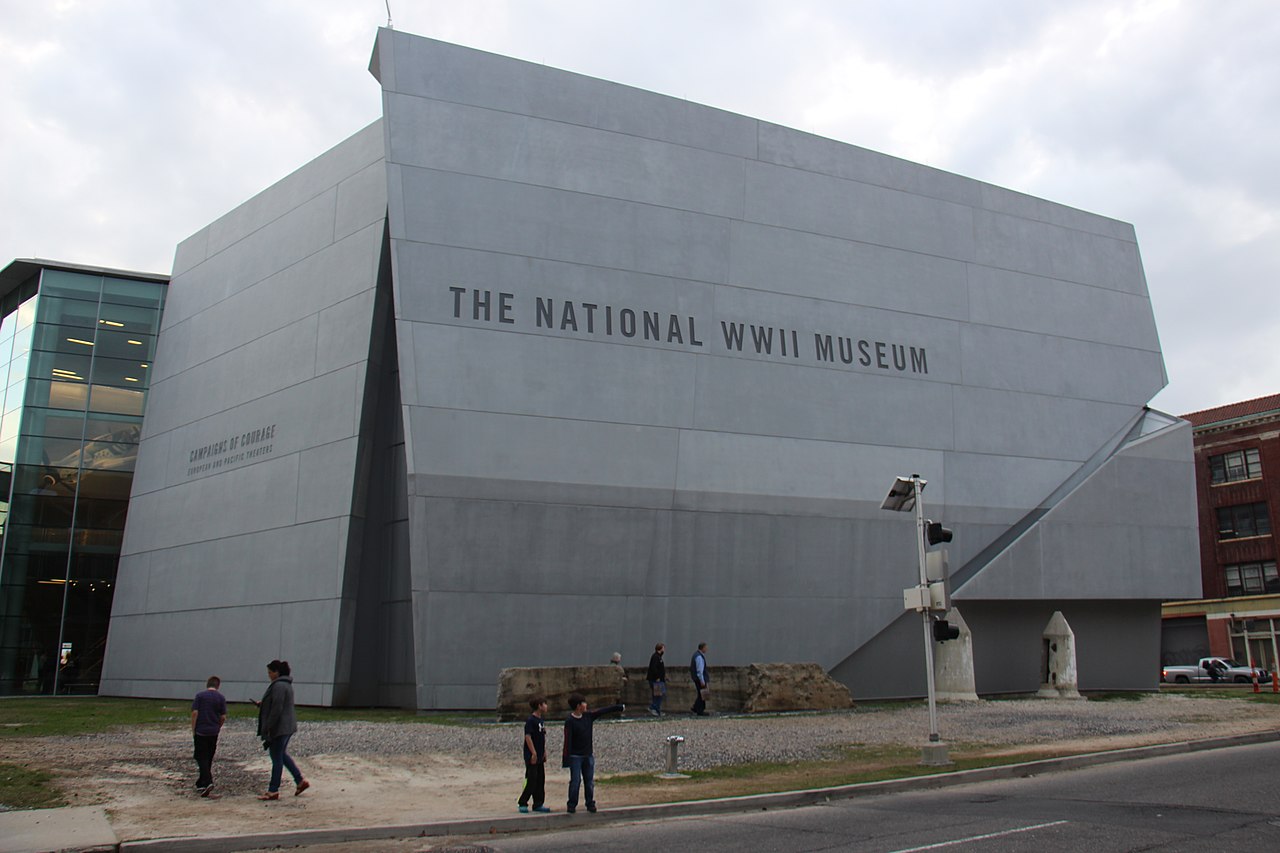May 1 is Mayday, which was established by the Society of American Archivists and Heritage Preservation, now part of the Foundation for Advancement in Conservation, to raise awareness of disaster preparedness and encourage preservation professionals to take responsibility for doing one thing to improve their readiness for disasters.
We recently sat down with Conserv customer Toni Kiser, the Assistant Director for Collections Management at The National WWII Museum, to talk about disaster preparedness and response at the museum and about her experiences with weathering storms in New Orleans.

View of Hurricane Katrina from space. How do you prepare for something like this coming your way? Image by NASA Goddard Space Flight Center from Greenbelt, MD, USA, CC BY 2.0, via Wikimedia Commons.
In Louisiana, seasons are measured a little differently, with seasons like Mardi Gras season, crawfish season, and hurricane season, which runs June 1st to November 30th each year.
While hurricanes are certainly not the only disasters to prepare for, they are certainly a major consideration for cultural heritage institutions and individuals, both in the Gulf South and beyond.
Last year’s Hurricane Ida caused major flooding and damage not only in the south, but all the way through to New York and New Jersey. Ida also struck on the 16th anniversary of Hurricane Katrina, which crystallized the importance of disaster planning, preparedness, and response.
“We did learn some really good lessons during Hurricane Katrina, a lot of the protocols we started after Katrina were based on that [experience]. For us, every hurricane is a little bit different, and something different happens every time we have a storm that has never happened before” said Toni.
Toni and her team at The National WWII Museum prepare both for the known knowns, like roof penetrations and other areas vulnerable to water intrusion, and the known unknowns.
“We try to make sure that all of our computers are draped with plastic and the countertops and carts are clear. We also try to make sure that people don’t have any collection materials in their offices (which they shouldn’t anyway), and we have protocols to make sure that there’s nothing at scanning stations.”
She laughed a bit and added “At some point, I just start carrying around scissors and rolls of Visqueen [polyethylene sheeting] saying ‘Who needs plastic?’”
The Team and the Plans – Who Stays? Who Goes?
The National WWII Museum’s emergency response team is headed by the Director of Security and includes a range of staff members, from the COO to visitor services staff. They meet regularly and run tabletop scenarios of things that could go wrong, not just hurricane scenarios.
Because “the plan” has so many specific sections for different physical areas of campus and departments of the museum, it’s not a printed document that someone grabs on their way out the door. For example, Toni said, “IT has very specific protocols that they go through to slowly shut down our servers until we get down to the essential servers that run on generator power. There are different areas and people with different responsibilities within those areas to prepare them for an emergency.” It’s definitely a team effort.
In addition, there’s a Stay Behind Team, explained Toni. It’s usually a group of security and facilities staff that stays on the museum’s campus from a few hours before the storm hits until it’s all done. For Hurricane Ida, this was 10-12 days later.
There’s also a secondary team, which for Ida included Toni, that has First Tier Reentry placards for their cars. In the event of a city-wide mandatory evacuation, these placards ensure that key workers can return before most residents are allowed back home.
A silver lining of Hurricane Ida was a wider dispersal of staff.
“It turned out to be really helpful that within departments that some people stayed and some people left. Communications were very difficult immediately after the storm – pretty much nobody had power or internet. It was really helpful that there were some people in Alabama, or in Texas or Florida, that had full power and full internet and they could keep operations going remotely, like issuing paychecks, communicating with vendors for resources needed onsite, and providing staff and volunteers with regular updates.”
Disaster Preparedness Supplies
The unique collection at The National WWII Museum and the climate in New Orleans allow Toni to be well-stocked with supplies. When asked about maintaining supplies, Toni mentioned that “luckily or not” they use their emergency supplies often enough that they’re not forgotten. The roof had chronic issues prior to its recent replacement, and in the subtropical climate of New Orleans, humidity and mold issues pop up at times in the museum.
Every year for Mayday, each department goes through its checklist of supplies and makes sure they are well stocked.
“One of the lessons learned from Katrina, Gustav, and other major storms is that having supplies on hand and not having to go find it or go get it is really key, and that you don’t always know what the emergency is going to be,” Toni said.
The collection at WWII also informs their emergency supplies. Because they have objects like tanks and airplanes in the collection, they keep rolls of absorbent matting designed for vehicle fluids on hand. This matting comes in huge rolls so there’s always plenty available. As part of preparations for a coming storm, Toni makes sure that emergency supplies are placed on carts in known locations so the Stay Behind team has ready access if needed.
Gasoline may not be the first item that comes to mind for a supply checklist, but it’s essential for places with generator backup power systems like WWII. “Because so much of the city lost power, getting gas was one of our biggest obstacles,” Toni said. As the museum expands, Toni expects fuel tank upgrades and possibly securing fuel supplier contracts in advance.
Real-time Risk Management during a Disaster
When you think about disaster response, you may imagine running into the building to rescue artifacts – in reality, you may be a lot more limited in terms of access. Toni in her role in Collections works closely with the Stay Behind team about how to move objects and when, rather than rushing in herself.
It’s important to weigh the benefits of action against the risks of intervention. For Hurricane Ida, Toni was able to use the real-time data from her Conserv sensors to monitor her collections storage spaces and provide direction to the Stay Behind team to act when necessary.
Toni explained that one of their storage spaces is not on the backup generator power system; it’s a well-insulated interior space that used to be the kitchen and mailroom for the museum. After the storm passed, the Stay Behind team verified there was no water damage, but once the power went out they were instructed to keep the door closed to maintain the climate as long as possible.
With Conserv sensors in that space, “I didn’t even need facilities to go in and tell me what the temperature and humidity were, I could see it,” Toni said.
From her house, Toni watched the temperature and humidity for four days before needing to act.
“As soon as it got in the range where I said, ‘Okay, this is a problem,’ we started figuring out a portable generator for a portable dehumidifier for that space. If we had been in and out even just once a day to check, we would have lost the environment a lot more quickly.”
With real-time data paired with the Conserv mobile app (Android and iOS.), Toni was able to remotely monitor the collection and direct her team to act when needed, even when she didn’t have power or internet service.
Lessons Learned from the Crescent City
We asked Toni if they review events after the fact. “Yep, we do, we have a debrief on every single one,” she replied. They ask what worked, what didn’t work, and what has worked in the past that didn’t work this time. “Every emergency, whether it’s a hurricane or not, brings about something that’s never happened before and that you just wouldn’t expect.”
In terms of things that people can forget to plan for, Toni mentioned lighting. “You always forget how dark it is in a windowless room. Flashlights, batteries, and lanterns are really helpful, and headlamps are really helpful.”
For collection items that are moved for the storm, Toni takes pictures with her phone and picks a key phrase to enter into her collections management database, such as “Moved in Preparation for Hurricane Barry,” that she can use to search for all the items she relocated for a storm when she’s back at work.
“Sometimes it’s hard to remember that you have your own house and things to take care of too,” Toni admitted. “It can be difficult when you feel like ‘Okay, I need to fix my roof, I need to fix my window,’ but we all have lots of connections to our collections and there’s a part of you that always feels like ‘No, I’m going to go to work and take care of that instead.”
We agreed that there’s a balance to be struck, and it’s not always easy. Flexibility is key, and people are remarkably resilient, especially in New Orleans.
Need some more help? Join the upcoming webinar!
On May 26th, Toni will be giving a Live Webinar: Creating an Emergency and Disaster Preparedness Plan.
After attending this webinar participants will be able to:
- explain the need for an emergency and disaster preparedness plan;
- outline the next steps to create an emergency and disaster preparedness plan for their organization;
- identify how an emergency and disaster preparedness plan can be used at their organization.
Disaster Preparedness and Response Resources
This Mayday, take one step to improve your readiness and disaster preparedness – let’s weather the storm together.
Here are Toni’s favorite resources for advice on disaster preparedness:
- Association of Registrars and Collections Specialists
- American Institute for Conservation
- National Park Service Conserv-o-grams
- Collections Stewardship Listserve
Some of our favorite resources on disaster preparedness:
- Heritage Emergency and Response Training and their continuing education webinars through the Smithsonian Cultural Resource Initiative
- MoMA, AIC-CERT, and FAIC resources compiled in the wake of Hurricane Sandy
- Smithsonian National Collections Program Emergency Kit Survey
Other case studies on disaster preparedness and remote environmental monitoring with Conserv
Interested in learning more about monitoring your environments remotely? You can read some of our other guest blog posts related to this topic:




